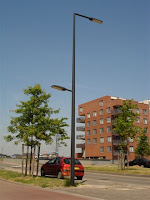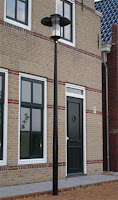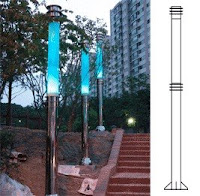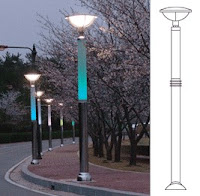Source: PUBLIC WORKS MAGAZINE
Publication date: June 13, 2008
By Sarah Goodale
Sarah Goodale is marketing manager for Sun Valley Lighting, Palmdale, Calif.
Street Lighting Innovations
It would be difficult to imagine any community without street lights. However, selecting fixtures that promote pedestrian and vehicle safety without over-lighting the surrounding landscape can be a challenge.
Most U.S. communities are committed to reducing light pollution or artificial 'sky glow,' the light that surrounds an urban area. Sky glow can result when light sources distribute light directly above a fixture's horizontal plane or indirectly from light that reflects upward from nearby surfaces. Advanced refractors and reflectors help meet today's 'dark sky compliant' mandates by directing light exactly where it is needed.
Reducing Light Pollution
Fixtures are now classified in four categories:
- Full cut-off. Light is not distributed at or above the fixture's horizontal plane.
- Cut-off. Aminimum amount of light is directed at a horizontal plane and light above the horizontal plane is within 2.5% of the total lamp lumens.
- Semi cut-off. Light above the horizontal plane is less than 5% of the total lamp lumens.
- Non cut-off. Aconsiderable amount of light is visible above the horizontal plane.
Today's fixtures feature precisionsegmented optics in a variety of light distribution patterns and lamp sizes and styles. Some fixtures, for example, have flat glass lenses to meet strict environmental standards; others are available with either vertical lamps for wide area lighting or horizontal lamps for roadway coverage.
Types of Lighting
Four types of lighting are used for most area and street lighting: fluorescent, metal halide, and high- and low-pressure sodium. LEDs are also becoming popular, but many communities are waiting for more extensive field testing before switching to them.
Fluorescent lights are often seen in commercial buildings. They are energyefficient, but operation in very cold temperatures can be an issue.
Metal halide offers a cool white light, is efficient, and uses long-lasting bulbs. It has good color rendition and is popular in street lighting.
Low-pressure sodium produces a yellow-orange light and is more efficient than high-pressure sodium. While the lamp's deep color makes it unacceptable for street lighting, it is useful for tunnels or near observatories.
High-pressure sodium is also efficient with longer-lasting lamps. It produces a warm golden-white color ideal for street lighting while delivering more light per Watt of electricity.
Finding a Fit
Many state transportation departments set standards for street lighting based on safe light levels for traffic. The most common choice for busy roadways has generally been a tall pole and a 'cobra head' fixture with a high-pressure sodium lamp.
However, in business districts that promote pedestrian traffic to restaurants and shops at night, walkway and streetscape lighting must be warm and inviting while addressing safety concerns. Lower intensity lights on shorter, closely spaced poles can light public areas without harsh shadows, which can be perceived as threatening.
Traditionally styled fixtures can enhance a revitalized downtown district by combining a vintage appearance with contemporary technology. These fixtures are available with full- and semi-cutoff light and a choice of light sources.
The most popular streetscape fixtures are made from heavy-wall cast aluminum construction and have a 3-mil polyester powder coating. In areas where vandalism is a concern, municipalities often select vandal-resistant fixtures constructed with metal cages around the lamps and finished with anti-graffiti coating on the pole and lamp head.
Selection Resources
During the initial stages of a new lighting project, a limited number of luminaires and related components should be identified for final selection. Manufacturers can provide resources such as design CDs, photometric information on mounting height recommendations and fixture spacing, layouts to assist with setting light levels and distribution, and submittal drawings of the selected assembly,including technical detail.
If there is a requirement to match existing luminaires, poles, or bases, the design team and in-house tooling department can be consulted about feasibility of reproduction. These services are typically available at no cost. Tooling costs for custom products can often be eliminated due to the large inventory of custom tooling available at major manufacturers.
When your community is ready to renovate existing lighting or is planning a new civic project, you can find environmentally sound fixture choices that offer the latest styling, technical advances, and low-cost maintenance features.













.jpg)



